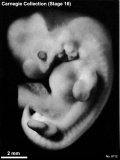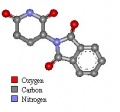K12 Professional Development 2016
| Embryology - 16 Apr 2024 |
|---|
| Google Translate - select your language from the list shown below (this will open a new external page) |
|
العربية | català | 中文 | 中國傳統的 | français | Deutsche | עִברִית | हिंदी | bahasa Indonesia | italiano | 日本語 | 한국어 | မြန်မာ | Pilipino | Polskie | português | ਪੰਜਾਬੀ ਦੇ | Română | русский | Español | Swahili | Svensk | ไทย | Türkçe | اردو | ייִדיש | Tiếng Việt These external translations are automated and may not be accurate. (More? About Translations) |
Introduction
This page introduces K12 teaching resources related to embryology and development. The current page is designed to help teachers find useful curated online resources for use in biology classes related to embryology and development. The content and links on this current page are under ongoing development, I am happy to receive feedback and requests for design of specific K12 content and exercises for your classes.
The initial resources I will be presenting relate to Thalidomide and Comparative Embryology.
Here is a link to my earlier K12 Professional Development 2014 presentation.
The section entitled Additional Useful Resources links directly to resources and currently there is no content designed for K12 student use, but content and resources on these pages may be useful in designing your own specific content around these topics.
Note that content on K12 pages has been simplified in both terminology and descriptions from that found on other embryology pages designed for university level students. That does not mean that other embryology pages are not useful for students, but may be to difficult to place in context given the advanced terminology and descriptions used on non-K12 pages.
Note that clicking the "Expand" text on pages will open collapsible tables with more information or resources.
| Content Reuse |
|---|
| Please note content on this site has been derived from a number of sources and under a range of different copyright conditions. I am happy for educational reuse in the classroom without republication. I specifically do not allow republication of content on the internet. This is to prevent misuse of content out of context and also to prevent multiple search results for the same content. In general, opening an image will show the specific copyright restrictions associated with the image.
Please contact me if you require information on educational reuse outside of your classrooms. Student exercise sheets have been designed to be printed and used in the classroom. |
Below are a list of the current K12 designed resources.
- Links: K12 Professional Development 2014 - Embryology for K12 Students | Museum of Human Disease - Professional Development Days
Comparative Embryology

|
This page has been designed as an introduction to Comparative Embryology. The page has 4 student exercises contained within collapsible tables. These exercises have worksheets that can be printed out to be completed by students. Also look at the series of student designed projects on animal development.
|
Thalidomide

Thalidomide molecular structure |
Thalidomide is a drug that was introduced on to the market on October 1, 1957 in West Germany. Thalidomide soon became a drug prescribed to pregnant women to combat symptoms associated with morning sickness.
When taken during the first trimester of pregnancy, thalidomide prevented the proper growth of the fetus resulting in horrific birth defects in thousands of children around the world. This is an example for students of inadequate drug testing and a lack of understanding of environmental effects on human development. This is often cited today as a reason to have significant testing of drugs before release and classification of drugs based upon their affects on development.
|
HSC NSW
| Biology Syllabus |
|---|
Blueprint of Life
|
External Links
External Links Notice - The dynamic nature of the internet may mean that some of these listed links may no longer function. If the link no longer works search the web with the link text or name. Links to any external commercial sites are provided for information purposes only and should never be considered an endorsement. UNSW Embryology is provided as an educational resource with no clinical information or commercial affiliation.
Glossary Links
- Glossary: A | B | C | D | E | F | G | H | I | J | K | L | M | N | O | P | Q | R | S | T | U | V | W | X | Y | Z | Numbers | Symbols | Term Link
Cite this page: Hill, M.A. (2024, April 16) Embryology K12 Professional Development 2016. Retrieved from https://embryology.med.unsw.edu.au/embryology/index.php/K12_Professional_Development_2016
- © Dr Mark Hill 2024, UNSW Embryology ISBN: 978 0 7334 2609 4 - UNSW CRICOS Provider Code No. 00098G
